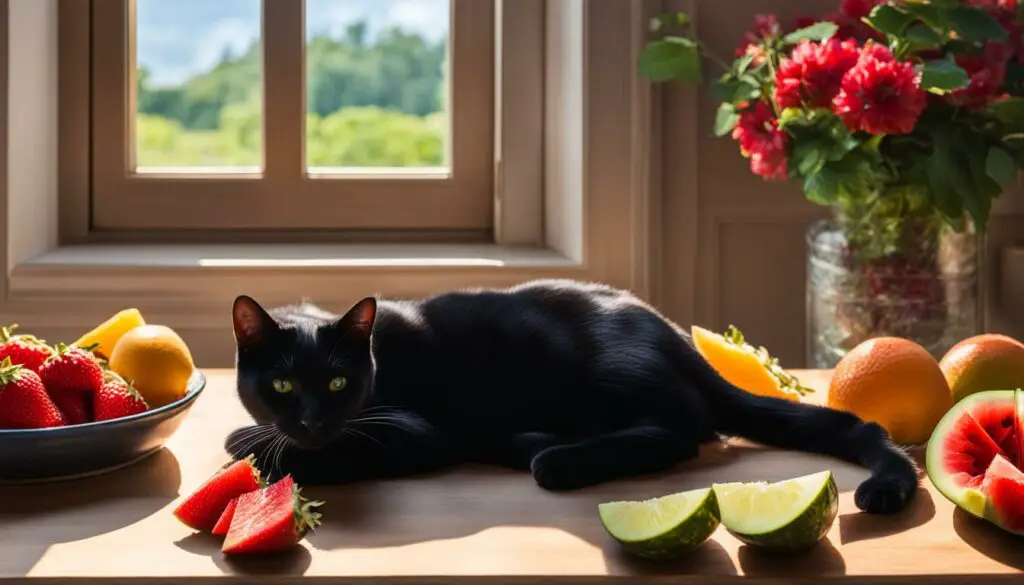Cats are carnivores, but did you know that there are certain fruits they can safely enjoy? Incorporating fruits into your cat’s diet can provide a range of health benefits, including essential vitamins, minerals, antioxidants, and fiber. However, it’s crucial to introduce fruits correctly and in appropriate portions to ensure your cat’s well-being.
Key Takeaways
- Certain fruits can be beneficial for cats, providing essential nutrients.
- Offer fruits in moderation to avoid digestive issues or potential harm.
- Make sure to choose cat-friendly fruits and remove any harmful parts.
- Fruits should only constitute a small percentage of a cat’s overall diet.
- Consult with a veterinarian before making any significant changes to your cat’s diet.
Can Cats Eat Bananas?
Cats can eat bananas in small amounts as a treat. Bananas are a good source of vitamins B6 and C, potassium, and carbohydrates. Sliced bananas, either fresh or frozen, can be offered to cats as an occasional treat. However, it’s important to remember that cats are not naturally attracted to the sweetness of fruits, so they may not show much interest in bananas.
When offering bananas to your cat, it’s essential to take some precautions. Firstly, remove the peel and slice the banana into small, cat-friendly portions. This will make it easier for your cat to consume and reduce the risk of choking. Additionally, ensure that the banana is ripe and not overripe, as overripe bananas can be more difficult for cats to digest.
While bananas can be a safe and healthy treat for cats, it’s important to remember that they should be given in moderation. Too much banana can disrupt a cat’s digestive system and potentially lead to gastrointestinal upset. As with any new food, it’s always a good idea to introduce bananas slowly and monitor your cat for any adverse reactions.
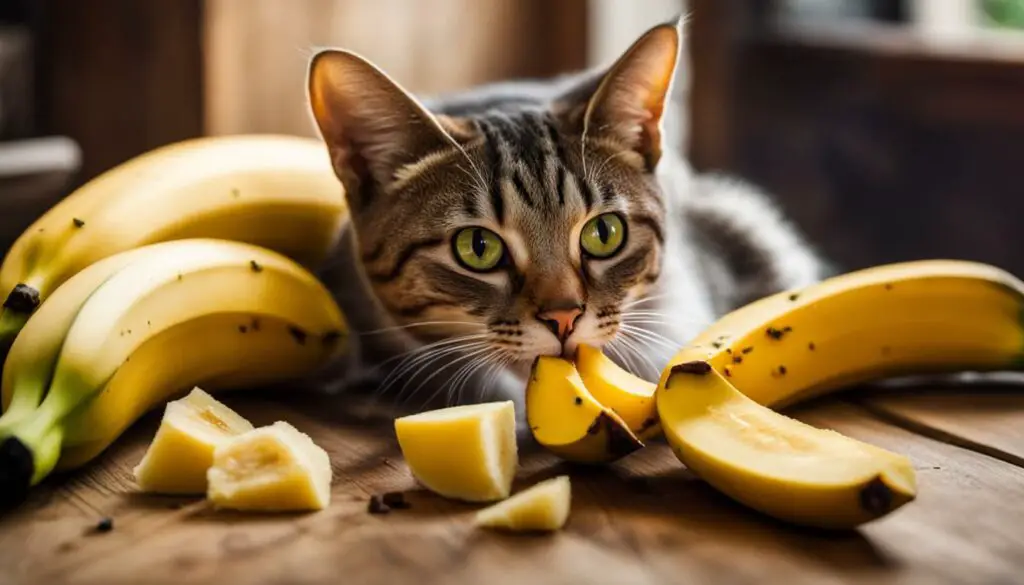
Can Cats Eat Bananas?
| Nutrients | Benefits |
|---|---|
| Vitamins B6 and C | Support the immune system and promote overall health |
| Potassium | Helps regulate blood pressure and maintain proper heart function |
| Carbohydrates | Provide energy for cats |
In conclusion, while cats can eat bananas, they should only be offered in small amounts as an occasional treat. Bananas can provide some nutritional benefits for cats, but it’s important to remember that they should not replace a balanced cat diet. If you have any concerns or questions about feeding your cat bananas or any other fruits, it’s always best to consult with your veterinarian for personalized advice and recommendations.
Can Cats Eat Watermelon?
Watermelon is safe for cats to consume, but it’s important to keep a few things in mind. While cats can enjoy a small portion of watermelon flesh on occasion, the rind and seeds should be avoided. If a cat accidentally ingests a pale seed from a “seedless” watermelon, it should not cause harm. However, excessive intake of watermelon or ingestion of the rind can lead to digestive issues in cats.
Watermelon provides a refreshing and hydrating treat for cats, especially during hot summer months. It is also rich in vitamins A and C, which can support a cat’s immune system and overall health. However, moderation is key when offering watermelon to cats, as it should not replace their regular balanced diet.
| Can Cats Eat Watermelon? | Yes |
|---|---|
| Benefits | Vitamins A and C |
| Cautions | Avoid rind and seeds |
| Portion | Small amounts as a treat |
When offering watermelon to cats, it’s best to cut it into small, bite-sized pieces to make it easier for them to chew and digest. It’s also important to ensure that the watermelon is ripe and free from any additives or sweeteners, as these can be harmful to cats. Additionally, it’s always a good idea to consult with a veterinarian before introducing any new food to your feline friend’s diet.
Can Cats Eat Strawberries?
Strawberries can be a delicious and nutritious treat for cats, but it’s important to offer them in moderation. These sweet berries provide cats with essential vitamins, antioxidants, and fiber. However, it’s important to prepare strawberries properly before offering them to your feline friend. Remove the stems and leaves, thoroughly wash the berries, and cut them into small, bite-sized pieces to prevent choking hazards.
Cats have different preferences when it comes to fruits, and not all of them may enjoy the taste of strawberries. While some cats may eagerly gobble up these juicy treats, others may show little interest. It’s important to observe your cat’s reaction when introducing strawberries and to respect their individual preferences.
Remember, even though strawberries are safe for cats to eat, they should be given in moderation. Giving your cat too many strawberries can lead to digestive issues like diarrhea. As with any new food, it’s always a good idea to consult with your veterinarian before adding strawberries or any other fruit to your cat’s diet.
Table: Nutritional Content of Strawberries for Cats
| Nutrient | Amount per 100g |
|---|---|
| Calories | 32 kcal |
| Carbohydrates | 7.7g |
| Fiber | 2g |
| Vitamin C | 58.8mg |
| Potassium | 153mg |
Strawberries can be a healthy and tasty addition to your cat’s diet when offered in moderation. However, it’s important to remember that each cat is different, and some may not enjoy the taste of strawberries. Always consult with your veterinarian before making any significant changes to your cat’s diet.
Can Cats Eat Blueberries, Raspberries, Cranberries, and Blackberries?
When it comes to cat-friendly fruits, it’s not just bananas and watermelons that cats can enjoy. Cats can also safely eat blueberries, raspberries, cranberries, and blackberries, in small amounts.
These berries are not only delicious but also packed with nutrients that can benefit your feline friend. They are high in antioxidants, flavonoids, and vitamins A, C, K, and E. These nutrients can support your cat’s overall health and wellbeing.
However, before offering these berries to your cat, it’s important to take some precautions. Cats have smaller digestive systems than humans, so it’s best to cut the berries into bite-size portions to avoid any choking hazards. Additionally, make sure to wash the berries thoroughly to remove any pesticides or contaminants.
To sum up, blueberries, raspberries, cranberries, and blackberries can make a tasty and nutritious addition to your cat’s diet. Just remember to offer them in moderation and prepare them appropriately to ensure your cat’s safety and enjoyment.
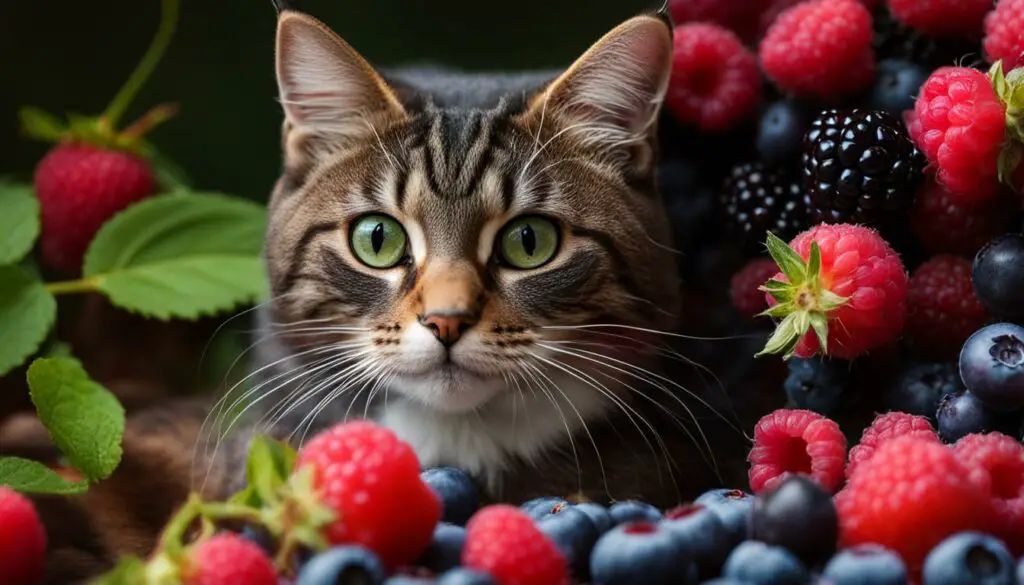
| Berry | Benefits |
|---|---|
| Blueberries | High in antioxidants and vitamins C and K |
| Raspberries | Rich in fiber and vitamins C and K |
| Cranberries | Contain antioxidants and may support urinary tract health |
| Blackberries | High in antioxidants and vitamins C and K |
As the table shows, each berry offers its own unique health benefits for cats. Incorporating a variety of these berries into your cat’s diet can provide them with a range of nutrients to support their overall health.
Can Cats Eat Apples?
Cats can safely eat apples and benefit from their nutritional content. Apples are a good source of calcium, vitamin C, vitamin K, and pectin. The flesh and skin of apples can be offered to cats in small slices or cubes. Apples are a cat-friendly fruit that can provide a range of health benefits. However, it’s important to avoid giving cats the stems and seeds of apples, as they can be harmful.
According to veterinarians, feeding cats apples in moderation is safe. Apples can be a refreshing and nutritious treat for cats, while also providing them with essential vitamins and minerals. However, it’s important to note that apples should not make up a significant portion of a cat’s diet. Fruits should only be given as occasional treats or as part of a balanced diet.
“Apples can be a healthy addition to a cat’s diet, but it’s essential to remove the stems and seeds,” says Dr. Emily Johnson, a veterinarian specializing in feline nutrition. “The seeds contain a compound called amygdalin, which can release cyanide when ingested in large quantities.”
When offering apples to cats, it’s best to slice them into small pieces to make it easier for them to eat. Some cats may not be interested in the taste or texture of apples, so it’s essential to gauge their preference and tolerance before incorporating them into their diet. As with any new food, it’s always recommended to consult with a veterinarian to ensure that apples are suitable for your cat.
| Fruit | Can Cats Eat? |
|---|---|
| Apples | Yes, in moderation and without stems and seeds |
| Bananas | Yes, in small amounts as a treat |
| Watermelon | Yes, in small portions without rind and seeds |
| Strawberries | Yes, in small amounts after removing stems and leaves |
| Blueberries, raspberries, cranberries, and blackberries | Yes, in bite-size portions |
| Mangos | Yes, as a treat without skin and seed |
| Pineapple | Yes, but remove leaves, thorns, and rind |
| Cantaloupe | Yes, in small cubes or slices without rind |
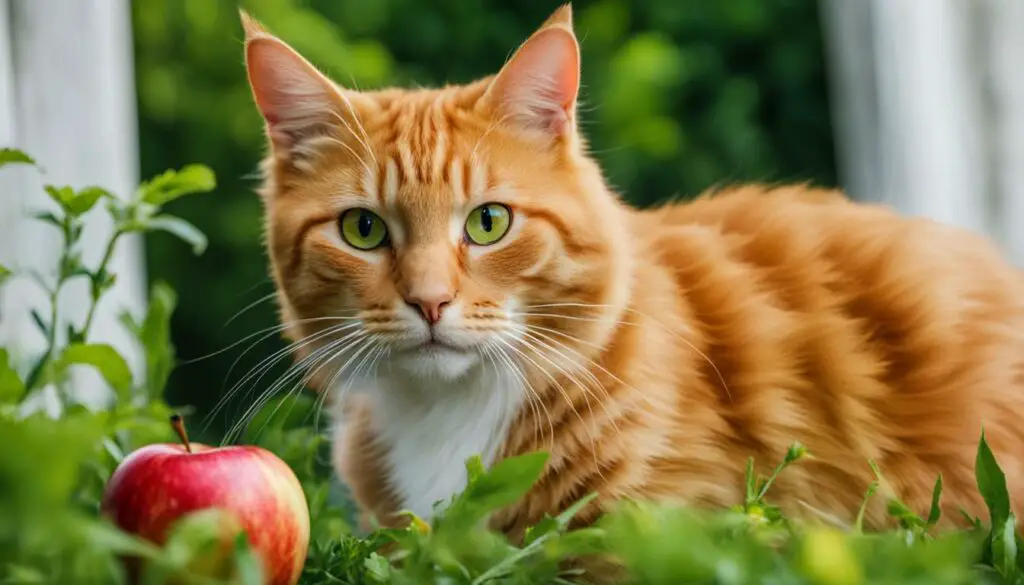
Can Cats Eat Mangos?
Cats can safely eat mangos as an occasional treat. Mangos are a delicious and nutritious fruit that provides cats with essential vitamins and minerals. They are rich in fiber, vitamin C, vitamin B6, and vitamin A, which can support your cat’s overall health and wellbeing.
When offering mangos to your cat, it’s important to remove the skin and seed, as they can be difficult for cats to digest. You can cut small cubes or slices of the mango flesh and offer them to your cat as a tasty snack. Remember to feed mangos in moderation as part of a balanced diet, as excessive consumption can lead to digestive issues.
| Benefits of Mangos for Cats |
|---|
| Mangos are rich in fiber, which can promote healthy digestion in cats. |
| The high vitamin C content in mangos can help boost your cat’s immune system. |
| Vitamin B6 in mangos can support your cat’s brain function and metabolism. |
| Mangos contain vitamin A, which is important for your cat’s vision and overall eye health. |
“Mangos can be a delicious and healthy treat for your cat, providing them with essential vitamins and fiber. Just remember to remove the skin and seed and offer them in moderation.”
Can Cats Eat Mango Skin?
No, cats should not eat mango skin. The skin of a mango can be difficult for cats to digest and may cause digestive upset or blockages. It’s important to remove the skin before offering mango to your cat.
Can Cats Eat Mango Seeds?
No, cats should not eat mango seeds. Mango seeds can be a choking hazard for cats and may cause digestive issues. Always make sure to remove the seed before offering mango to your cat.
Remember, while mangos can be a healthy treat for cats, they should be given in moderation. It’s important to consult with your veterinarian before introducing any new foods into your cat’s diet, especially if your cat has any specific dietary restrictions or health conditions.
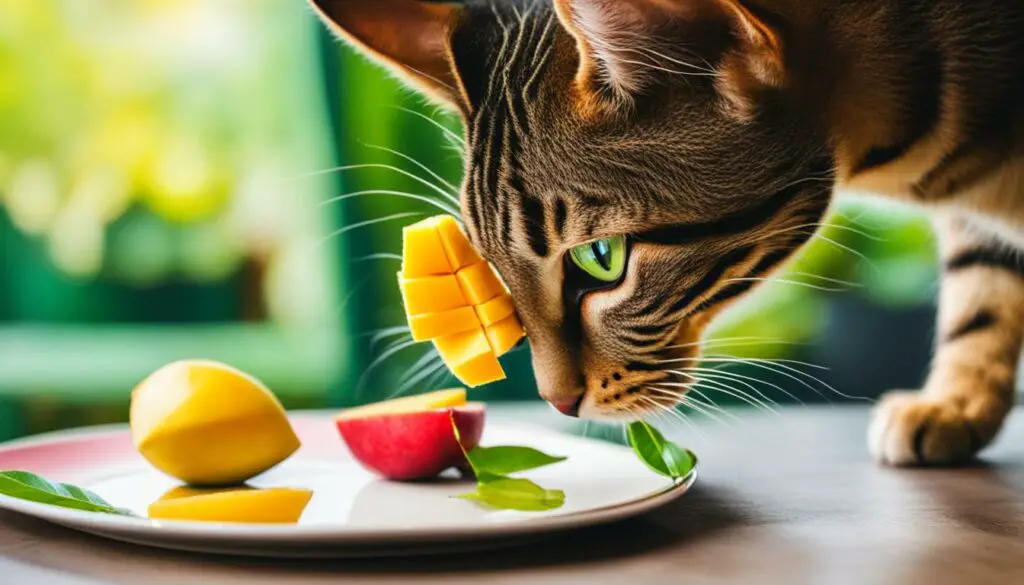
Can Cats Eat Pineapple?
Cats can eat pineapple, but there are a few precautions to consider. Pineapple is high in fructose and contains vitamins A, B6, C, and minerals like magnesium and potassium. Fresh pineapple is preferred over canned varieties, which may contain sugary syrups and preservatives. Before offering pineapple to cats, it’s important to remove the leaves, thorns, and rind completely.
| Benefits of Pineapple for Cats | Precautions When Feeding Pineapple to Cats |
|---|---|
|
|
It’s important to remove the leaves, thorns, and rind of pineapple completely before offering it to cats to prevent any potential hazards or digestive issues.
While pineapple can provide certain health benefits for cats, it’s essential to feed it in moderation and as part of a balanced diet. As with any new food, it’s recommended to consult with a veterinarian before introducing pineapple or any other fruit into your cat’s diet. They can provide specific guidance based on your cat’s individual needs and health condition.
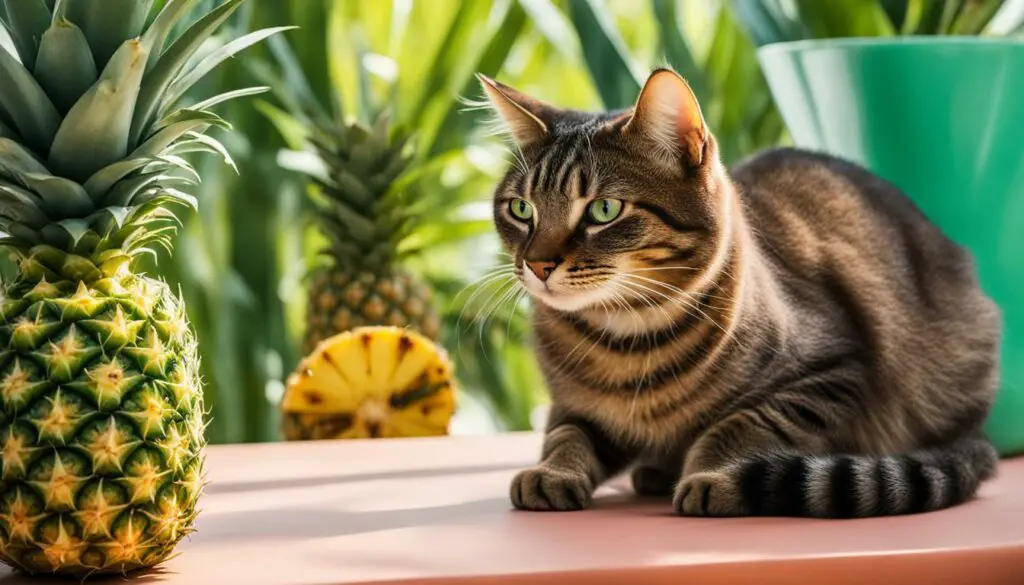
Pineapple and Cats: Key Points to Remember
- Cats can safely eat pineapple, but the leaves, thorns, and rind must be removed.
- Fresh pineapple is preferred over canned varieties.
- Pineapple should be introduced gradually and in moderation.
- Consult with a veterinarian before making any significant changes to your cat’s diet.
Can Cats Eat Cantaloupe?
Many cat owners wonder if it is safe for their furry friends to enjoy cantaloupe. The good news is that cats can indeed eat cantaloupe and benefit from its nutritional value. Cantaloupe is a delicious and refreshing fruit that is rich in vitamin C, beta carotene, fiber, and antioxidants. These nutrients can provide various health benefits for cats, including promoting a strong immune system and supporting healthy digestion.
When offering cantaloupe to cats, it is important to remember a few key points. Firstly, the flesh of the cantaloupe is safe for cats to eat, but the rind should be avoided. The rind can be tough and difficult for cats to digest, so it is best to remove it before serving. Additionally, it is important to cut the cantaloupe into small cubes or slices to make it easier for cats to eat. This helps reduce the risk of choking hazards and ensures that they can safely enjoy the fruit.
It’s worth noting that cantaloupe has a unique scent that can be particularly appealing to cats. The scent of cantaloupe mimics the scent of proteins found in meat, which may explain why some cats are drawn to this fruit. However, it’s still important to introduce cantaloupe gradually and in moderation, as with any new food, to monitor your cat’s reaction and ensure they tolerate it well.
| Benefits of Cantaloupe for Cats | Safety Precautions |
|---|---|
|
|
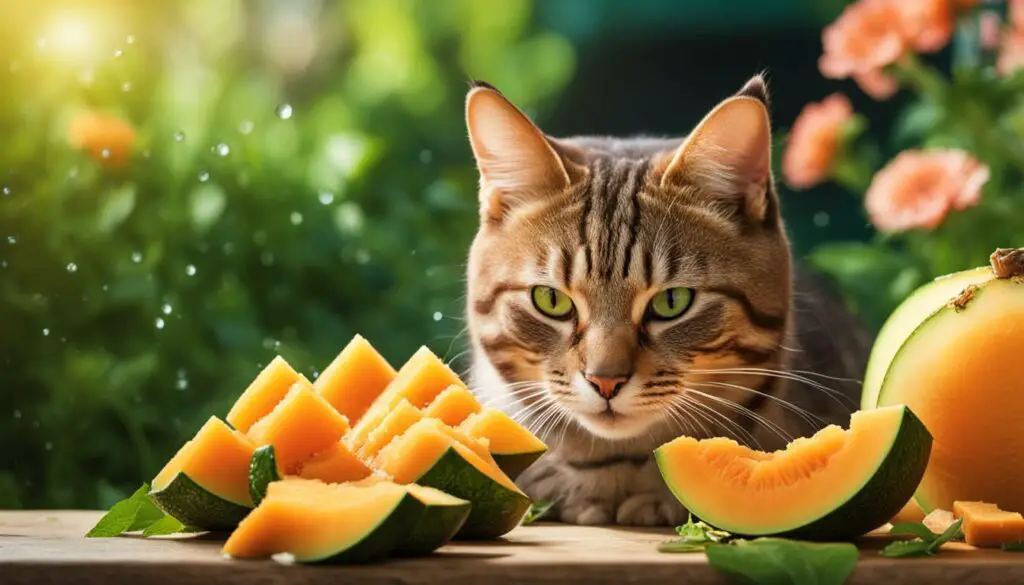
It’s important to note that while cantaloupe can be a healthy addition to a cat’s diet, it should not replace their regular meals. Cats are obligate carnivores, and their primary source of nutrition should still come from high-quality cat food that meets their dietary requirements. Cantaloupe should be offered as an occasional treat and should not exceed more than 2% of a cat’s daily food intake.
As always, it is advisable to consult with a veterinarian before introducing any new foods into your cat’s diet. They can provide personalized guidance based on your cat’s specific health needs and dietary requirements. With proper care and moderation, cantaloupe can be a safe and enjoyable treat for your feline friend.
How Much Fruit Can a Cat Have?
Fruits can be a healthy addition to a cat’s diet, but it’s important to remember that cats are obligate carnivores. While fruits can provide some nutritional benefits, they should not make up a large portion of a cat’s diet. The recommended amount of fruit for a cat is no more than 2% of their daily food intake, which is roughly equivalent to a 1-inch portion each day. It’s important to offer fruits as a treat or supplement to their regular pet food, rather than as a main source of nutrition.
When feeding fruits to cats, it’s crucial to choose cat-friendly fruits that are safe for their consumption. Fruits like bananas, watermelon, strawberries, blueberries, raspberries, cranberries, blackberries, apples, mangos, pineapples, and cantaloupe can be given to cats in small amounts. However, it’s important to remove any seeds, stems, pits, cores, rinds, or other inedible parts before offering them to cats.
It’s worth noting that diabetic cats should not be given fruit due to its high sugar content. Additionally, if you have any concerns or questions about incorporating fruits into your cat’s diet, it’s always best to consult with a veterinarian who can provide personalized advice based on your cat’s specific needs.
| Fruit | Benefits | Serving Size | Precautions |
|---|---|---|---|
| Bananas | Source of vitamins B6 and C, potassium, and carbohydrates | Small slices or frozen pieces | Cats may not show much interest due to lack of natural attraction to sweetness |
| Watermelon | Source of vitamins and antioxidants | Small portion of flesh, avoiding rind and seeds | Too much watermelon or ingestion of rind can lead to digestive issues |
| Strawberries | Source of vitamins, antioxidants, and fiber | Stems and leaves removed, washed and cut into small pieces | Large amounts should be avoided due to potential digestive issues |
| Blueberries, Raspberries, Cranberries, and Blackberries | High in antioxidants, flavonoids, fiber, and vitamins | Cut into bite-size portions to avoid choking hazards | Remove any stems or leaves |
| Apples | Source of calcium, vitamin C, vitamin K, and pectin | Small slices or cubes, avoiding stems and seeds | Remove any stems or seeds |
| Mangos | Rich in fiber, vitamins, and minerals | Small cubes or slices, avoiding skin and seed | Avoid giving cats the skin and seed |
| Pineapple | High in fructose, vitamins, and minerals | Fresh pineapple without leaves, thorns, and rind | Fresh pineapple is preferred over canned varieties |
| Cantaloupe | Source of vitamin C, beta carotene, fiber, and antioxidants | Small cubes or slices, avoiding rind | Avoid giving cats the rind |
Other Fruits That Are Safe for Cats
Aside from the fruits mentioned earlier, there are several other fruits that are safe for cats to consume in small quantities. These fruits provide additional variety and nutritional benefits to a feline’s diet:
- Apricots: Apricots are a good source of vitamins A and C. Cats can enjoy small, diced pieces of apricot flesh as an occasional treat.
- Cucumber: Cucumbers are mainly composed of water and are low in calories, making them a refreshing and hydrating snack for cats. Sliced cucumber can be offered as a treat.
- Honeydew: Honeydew melon is a good source of vitamins A and C. Cats can enjoy small, diced pieces of honeydew as an occasional treat.
- Kiwi: Kiwi is rich in vitamin C, vitamin K, and fiber. Cats can have small, diced pieces of kiwi flesh as an occasional treat.
- Nectarines: Nectarines are a good source of vitamins A and C. Cats can enjoy small, diced pieces of nectarine flesh as an occasional treat.
- Pears: Pears are a good source of fiber and vitamins C and K. Cats can have small, diced pieces of pear flesh as an occasional treat.
When offering these fruits to cats, it’s important to remove any seeds, stems, pits/cores, and rinds to prevent choking hazards or potential digestive issues. Additionally, it’s always wise to introduce new fruits gradually and monitor your cat’s reaction for any signs of allergies or adverse effects.
Remember, while these fruits are generally safe for cats, they should still be given in moderation and should not replace a balanced feline diet. Consult with your veterinarian before making any significant changes to your cat’s diet or introducing new foods.
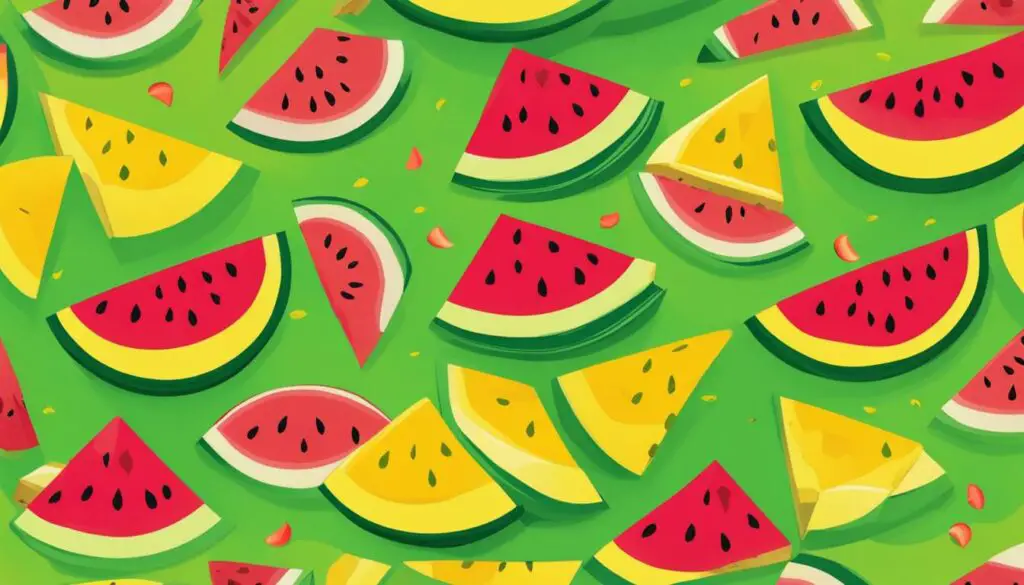
Fruits That Are Not Safe for Cats
While there are several fruits that cats can safely enjoy, there are also some fruits that are not safe for them to consume. It is important to be aware of these fruits and avoid giving them to your feline companion to prevent any potential harm or health issues.
The first fruit to avoid is grapes and raisins. These fruits can cause serious digestive issues and even acute kidney failure in cats. It’s best to keep grapes and raisins out of your cat’s reach and never offer them as a treat.
Another fruit to avoid is citrus fruits like lemons, limes, and oranges. These fruits can cause digestive irritation in cats and may lead to other health problems. It’s important to keep citrus fruits away from your cat and not offer them any citrus-flavored treats or foods.
| Fruits to Avoid | Reasons to Avoid |
|---|---|
| Grapes and Raisins | Potential for digestive issues and acute kidney failure. |
| Citrus Fruits (lemons, limes, oranges) | Can cause digestive irritation and other health problems. |
By being aware of these fruits that are not safe for cats, you can ensure the well-being and health of your feline friend. Always consult with your veterinarian if you have any concerns or questions about the fruits that are safe or not safe for your cat to eat.
Which Other Human Foods Are Safe for Cats?
While fruits can be a nutritious addition to a cat’s diet, there are other human foods that cats can safely enjoy in moderation. These foods provide a variety of nutrients and flavors that can help keep your feline friend happy and healthy. Here are some human foods that are safe for cats:
Artichokes:
Artichokes are rich in antioxidants, fiber, and vitamins C and K. They can be served cooked or raw, but make sure to remove any tough outer leaves and the fuzzy choke before offering them to your cat.
Asparagus:
Asparagus is a good source of vitamins A, C, E, and K, as well as folate and fiber. Cooked asparagus spears can be given to your cat in small, bite-sized pieces.
Broccoli:
Broccoli is packed with vitamins C and K, fiber, and antioxidants. Steam or boil the broccoli until it’s soft, and then cut it into small florets to make it easier for your cat to eat.
Cabbage:
Cabbage is low in calories and high in vitamins C and K. Offer small, finely shredded pieces of raw cabbage to your cat as an occasional treat.
Remember, these human foods should only be given sparingly and as a special treat. Always consult with your veterinarian before introducing any new foods to your cat’s diet to ensure that they are safe and appropriate for your furry friend.
| Human Foods Safe for Cats |
|---|
| Artichokes |
| Asparagus |
| Broccoli |
| Cabbage |
Which Human Foods Are Toxic for Cats?
Overview
Cats have specific dietary needs, and while some human foods can be safely incorporated into their diets, it is important to know which foods are toxic and should be avoided. Feeding cats the wrong foods can lead to digestive issues, toxicity, or even life-threatening conditions. It is always best to consult with a veterinarian before introducing any new foods into your cat’s diet. Below, you will find a list of human foods that are toxic to cats and should never be given to them.
Toxic Human Foods for Cats
| Foods | Toxicity |
|---|---|
| Chives | Can cause gastrointestinal upset, damage to red blood cells, and potentially lead to anemia in cats. |
| Garlic | Similar to chives, garlic can cause digestive issues and damage to red blood cells. |
| Green Tomatoes | Contain solanine, a toxic substance that can cause gastrointestinal upset, weakness, and even seizures in cats. |
| Leeks | Can cause digestive upset, damage to red blood cells, and potentially lead to anemia in cats. |
| Wild Mushrooms | Many types of mushrooms are toxic to cats and can cause severe gastrointestinal issues, liver damage, or even organ failure. |
| Onion | Contains compounds that can cause oxidative damage to a cat’s red blood cells, leading to anemia. |
| Rhubarb | The leaves of rhubarb contain oxalates, which can cause kidney damage and other health issues in cats. |
Precautions to Take
When preparing meals or sharing food with your cat, it is crucial to avoid any foods that fall into the toxic category. Make sure to store these foods safely, out of your cat’s reach, and educate family members or visitors about the potential dangers. In case of accidental ingestion, contact your veterinarian immediately for guidance and support. Remember, prevention is key when it comes to keeping your cat safe and healthy.
Conclusion
In conclusion, incorporating fruits into a cat’s diet can provide added nutrition and variety. While cats are carnivores by nature, they can safely enjoy certain fruits in moderation. These fruits, such as bananas, watermelon, strawberries, blueberries, apples, mangos, pineapple, and cantaloupe, offer vitamins, fiber, and antioxidants that can benefit cats’ overall health.
It’s important to remember that fruits should only make up a small portion of a cat’s diet, about 2% or a 1-inch portion per day. Fruits can be given as an alternative to traditional cat treats, especially for cats that need to lose weight. However, it’s crucial to offer fruits separately from regular pet food and avoid giving them to diabetic cats due to the high sugar content.
While some human foods are safe for cats, it’s essential to know which ones to avoid. Grapes, raisins, citrus fruits, chives, garlic, and onions are toxic to cats and should never be given to them. Additionally, it’s best to remove any seeds, stems, pits, rinds, and roots from fruits and other human foods before offering them to cats.
Always consult with a veterinarian before making any significant changes to a cat’s diet. They can provide guidance specific to your cat’s health and dietary needs. With proper introduction and portion control, cat-friendly fruits can be a tasty and nutritious addition to your furry friend’s meals.
FAQ
Can cats eat bananas?
Yes, cats can eat bananas in small amounts as a treat. Bananas provide vitamins B6 and C, potassium, and carbohydrates.
Can cats eat watermelon?
Cats can eat a small portion of watermelon flesh on occasion. However, the rind and seeds should be avoided to prevent digestive issues.
Can cats eat strawberries?
Cats can eat strawberries in small amounts. Before offering strawberries to cats, it’s important to remove the stems and leaves, wash them thoroughly, and cut them into small pieces to avoid choking hazards.
Can cats eat blueberries, raspberries, cranberries, and blackberries?
Yes, cats can eat these berries in small bite-size portions. These berries are high in antioxidants, flavonoids, and fiber.
Can cats eat apples?
Yes, cats can eat apples. The flesh and skin of apples can be offered to cats in small slices or cubes, but the stems and seeds should be avoided.
Can cats eat mangos?
Cats can eat mangos as a treat. Small cubes or slices of the flesh can be offered, but the skin and seed should be avoided.
Can cats eat pineapple?
Cats can eat pineapple, but it is important to remove the leaves, thorns, and rind completely. Fresh pineapple is preferred over canned varieties.
Can cats eat cantaloupe?
Yes, cats can eat cantaloupe. Small cubes or slices of the flesh can be offered, but the rind should be avoided.
How much fruit can a cat have?
Fruits should be limited to no more than 2% of a cat’s diet, which is about a 1-inch portion each day. Always consult with a veterinarian before making any significant changes to a cat’s diet.
What other fruits are safe for cats?
Other safe fruits for cats include apricots, cucumber, honeydew, kiwi, nectarines, and pears. It is important to avoid the seeds, stems, pits/cores, and rinds of these fruits.
What fruits are not safe for cats?
Grapes, raisins, lemons, limes, oranges, chives, garlic, green tomatoes, leeks, wild mushrooms, onion, and rhubarb are not safe for cats and should be avoided.
Which other human foods are safe for cats?
Cats can also safely enjoy other human foods in moderation, such as artichokes, asparagus, beans, broccoli, cabbage, carrot, cauliflower, celery, coconut, eggplant, ginger, green beans, lettuce, olives, peas, peppers, pumpkin, sweet potato, and winter squash. It is important to remove any seeds, stems, pits/cores, and rinds before offering these foods to cats.
Which human foods are toxic for cats?
Foods that are toxic for cats include chives, garlic, green tomatoes, leeks, wild mushrooms, onion, and rhubarb. Additionally, most seeds, stems, pits, rinds, and roots should be avoided.

